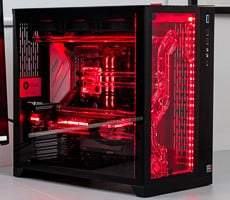Maingear Rush Review With Radeon R9 295X2 CrossFire
|
PCMark 7 runs through the types of tasks your PC is likely to encounter during ordinary home and office use. It tests the system’s graphics capabilities as well, but it isn’t mean to test the limits of high-end, discrete graphics card. Look at the two PCMark benchmarks as an indicator of a system’s general usage performance.



The Rush stumbled a bit in PCMark 7, posting a middling score of 6208. Its beastly GPU setup isn’t much help here, but it’s nevertheless a bit underwhelming.
We're still building a database of PCMark 8 scores, hence the lack of comparison charts, but above is what the Rush delivered in several tests within that particular benchmark.
|
Although Futuremark’s 3DMark 11 has been around for several years, it still provides a good look at a system’s gaming capabilities. It's also handy tool for benchmarking machines that still run Windows 7. We ran this benchmark on the Performance preset, at 1280 x 720 resolution. If you download the free version of this benchmark, make sure you're using the Performance preset to avoid comparing scores that were run with different test configurations.
In 3DMark 11, the Rush regains its footing. Its score of 27706 put the system far ahead of even the Epic Rush, which itself embarrassed the rest of the field by a longshot.
|
3DMark Fire Strike has two benchmark modes: Normal mode runs at 1920x1080, while Extreme mode targets 2560x1440. GPU target frame buffer utilization for normal mode is 1GB and the benchmark uses tessellation, ambient occlusion, volume illumination, and a medium-quality depth of field filter. The more taxing Extreme mode targets 1.5GB of frame buffer memory and increases detail levels across the board. Extreme mode is explicitly designed for CrossFire / SLI systems. GT 1 focuses on geometry and illumination, with over 100 shadow casting spot lights, 140 non-shadow casting point lights, and 3.9 million vertices calculated for tessellation per frame. And 80 million pixels are processed per frame. GT2 emphasizes particles and GPU simulations. Tessellation volume is reduced to 2.6 million vertices and the number of pixels processed per frame rises to 170 million.






